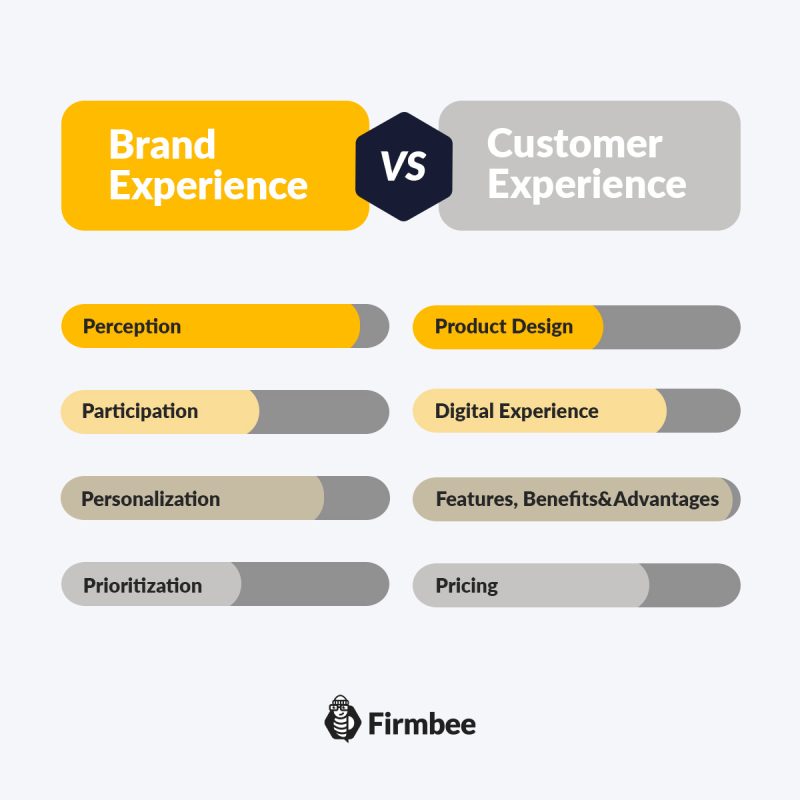What is a brand experience? Brand experience (brand experience) is customers’ long-lasting impression of a brand. It encompasses both their feelings, thoughts, perceptions together with reactions to a brand from its marketing efforts to product introduction and distribution. There are four main areas that form brand experience.
Brand Experience – table of contents:
- Brand experience – four areas that form brand experience
- Brand experience vs. customer experience
- How to create a brand experience strategy
- Summary
Four areas that form brand experience
Perception is undoubtedly a key part of the experience. It encompasses audio-scent or visual interactions that allow customers to connect a specific message to the brand’s advertising campaigns.
Examples include particular sounds or smells that evoke childhood memories, translating into building positive experiences. Brands that successfully combine the senses with marketing activities can effectively influence the decisions and behavior of their consumers.
2. Participation
Likely, customers involved in some way with a brand (not just an observer, but a participant) will walk away with a positive brand experience.
Customer participation activities can include, for example, the ability to send suggestions online or interact on social media (recording lives streams, sharing photos and customer testimonials via a company profile), as well as displaying physical installations that allow consumers to touch the product.
3. Personalization
Personalization can help create promotions and products targeted to a particular customer segment. Using both user-provided data (e.g., in the form of a contact form) and the user’s social media activities, it is possible to create more personalized activities that help find a connection between consumer needs and the brand’s current product offerings.
4. Prioritization
You can never perfectly tailor the brand experience to the requirements and needs of each customer. Still, it is worth choosing brand indicators – such as positive mentions on social media or repeat purchases – to prioritize and focus on a specific area in shaping your brand experience strategy.
Brand experience vs. customer experience
Brand experience and customer experience inherently focus on the same thing – the customer. Both relate to their experience. What distinguishes them, however, is that brand experience satisfies the consumer’s needs before he or she even becomes a customer. In contrast, customer experience helps guide him or her through the entire transaction or interaction with the brand.

Brand experience, then, is a certain preparation for welcoming customers and providing them with the best possible experience. Customer experience, on the other hand, refers to the personal feelings and experiences of an individual customer.
How to create a brand experience strategy
1. Assessing the fulfillment of customers’ expectations of the brand
In the first step of creating a strategy, identify areas where your brand’s current experience does not meet real customer expectations. Talking to customer service, analyzing traffic on the brand’s website and social media, or conducting surveys with current customers (or potential customers) and learning about their pain points and expectations can help identify the problems. Subsequent analysis of the collected data can help formulate the basis of a brand experience strategy.
2. Identifying areas for improvement
The next step in creating a brand experience strategy is to target an area for improvement. Of course, you may identify more than one aspect of the brand experience that needs modification or redesign. However, trying to fix everything at once is not the best idea. Keeping prioritization in mind, work out which area you will focus on first, and which you will refine in subsequent stages.
3. Measuring the effects
Once you have successfully identified areas for improvement and redesigned them, remember to monitor progress and measure the effects of your actions. You can conduct surveys or interviews with users, analyze website traffic data, customer reactions on social media as well as reviews. This is also the time to innovate by testing different possible strategies to see which works best. From marketing campaigns to offering personalized services, changes in customer service, post-purchase service as well as the store design.
Summary
A carefully crafted brand experience strategy can therefore play a key role in building and nurturing long-term customer relationships.
By being able to identify areas for improvement, setting priorities together with planning the strategy accordingly, it is possible to build a brand experience that will improve customer relationships and encourage customers to continue using your services/products, recommend the brand and convince them to remain loyal customers.
If you like our content, join our busy bees community on Facebook, Twitter, LinkedIn, Instagram, YouTube, Pinterest.
Author: Klaudia Kowalczyk
A graphic & UX Designer which conveys into design what cannot be conveyed in words. For him, every used color, line or font has a meaning. Passionate in graphic and web design.
The ultimate UX Guide:
- What is UX – and what it is NOT
- UX and UI – are they comparable?
- 7 factors of (outstanding) User Experience
- Do you know what UX Design means?
- Are you designing user experiences? Take care of these things!
- 10 usability heuristics for UX design you need to know
- The UX design process in 5 easy and simple steps
- User-centered design and its main principles
- Stages of User-Centered Design process
- What is Customer Experience?
- User Experience vs Customer Experience. A simple explanation of their relationship
- What is a Brand Experience?
- What is Human-Computer Interaction (HCI)?
- Why UX is important?
- Usability vs functionality in UX
- Examples of good UX design


















